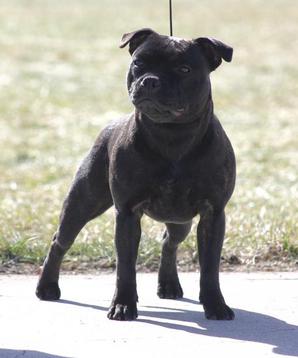Puppies
 | ||||
 | ||||
 | ||||
Copyright © 2012 Dyna Staffs
All of our puppies come with a guarantee that if ever at any time you find yourself in a position that you can no longer care for your dog we will take it back no questions asked. We will make sure that the dog is placed in a loving home or remain with us. We will also help place any puppies from other breeders, again no questions asked. These are loving dogs that require a lot of human interaction and love. We will help in any way possible. Also if you are looking for a rescue Stafford please let us know. We would love to place you with a rescue in need of love.
Before Placing deposits please know our policy on NON refundable deposits and policies regarding payments. We expect our buyers to be responsible puppy owners. If for any reason WE cancel the purchase your deposit, and any payments made, will be refunded in part or whole depending on the situation. If for any reason we do not have a puppy for you in our next litter, we reserve the right to move you to a future litter of equal or better quality, if you agree. If we agree that you will not be getting the puppy you expected by waiting we will issue you a full refund. If YOU cancel, or make false statements, representations etc. in order to obtain a puppy, resulting in cancelation your deposit is NOT refundable.
Please note Staffordshire Bull Terriers (and most bully breeds) have a weaker immune system in general, so compounding the issue with breeding for color is never a good thing. Some Staffords are prone to food and skin allergies without adding in the dilute gene. Please read the following and take it very seriously when considering a Stafford just for color.
This is why we do NOT breed for blues, and please take this seriously, it is a very serious issue in our breed. Please note the pic of the blue Stafford below, bald patches, thin hair and it has severe itching all the time.
What is color dilution alopecia?
Colour Dilution Alopecia (CDA) is a condition of hereditary skin and is more common in dogs reared for a color of the diluted mantle. For Adult dogs with inherited gene, it is also considered a form of follicular dysplasia. It is more commonly found in dogs with a blue or fawn cape. These two colors of the mantle were diluted by black and red / Brown. Alopecia is a disorder that causes complete or partial loss of hair permanently. It hits the follicle follicle at the lower level of the dog's skin, causing it to self-destruct, making the new hair growth impossible. [..] the color dilution alopecia (CDA) also causes the loss of fur and skin problems, including Squamosità and itchy skin. It may also present recurrent bacterial infections.
Symptoms:
- loss of fur: the first symptom of CDA is the loss of fur, although this will not show up until the dog has at least six months and often up to three years.
- broken hair, known as "stubbl alopecia": this may change the skin, Papules (swelling that does not produce pus) and pustules (with pus)
- dry and scaly skin
- recurrent bacterial infections (usually found on the back of the dog and can be identified by infected hair follicles, which appear to be small bumps
- skin infections with strong itching
Types:
The board may be interested in many races, although it may only affect certain individual dogs within these races. These individual dogs are recognizable by the color of the truffle, from the edges of the eyes and lips that can be lavender, Blue-Grey or blue. The Color of the cape may vary from fawn, Blue, Blue Fawn (Blue-Fawn) or bronze.
Cause:
- the most significant cause of color dilution alopecia is inheritance, although dogs that are affected by the recessive gene are born with a healthy appearance.
- the amount of dilution in the dog is assumed to result in the severity of alopecia.
- the d-Locus Gene controls the hue of the hair color
- an undiluted dog will have a normal colouring with a dd gene or a dd gene.
- diluted dogs will have a dd gene, evident from nose color (Blue)
- because dilution is a recessive gene, only dogs carriers of the dd gene can be affected, even if a dog in possession of the dd gene will be a carrier
- since the cause of CDA is not fully understood, it is thought that loss of fur happens for their formation of colouring that is fatal to hair follicles
The board may be bypassed for non-breeding dogs and not carrying color dilution; this includes dogs that are not only directly affected by the "DD" Gene and also by their children and parents.
Genetic testing for mutation "C.- 22 g>a" are available for the identification of the mlph gene and are recommended for all breeding subjects with blue.
Please read our puppy deposit policy at the bottom of this page before placing a deposit.
Planned Breeding of 2025. We will be breeding Beorn to Jade in the Spring of 2025. If Interested in this litter, Please fill out the Puppy Form
X
"Beorn"
"Jade"
Planned Breeding of 2024. We will be breeding Bentley to Vera in the Fall of 2024. If Interested in this litter, Please fill out the Puppy Form
X
"Bentley"
"Vera"
















